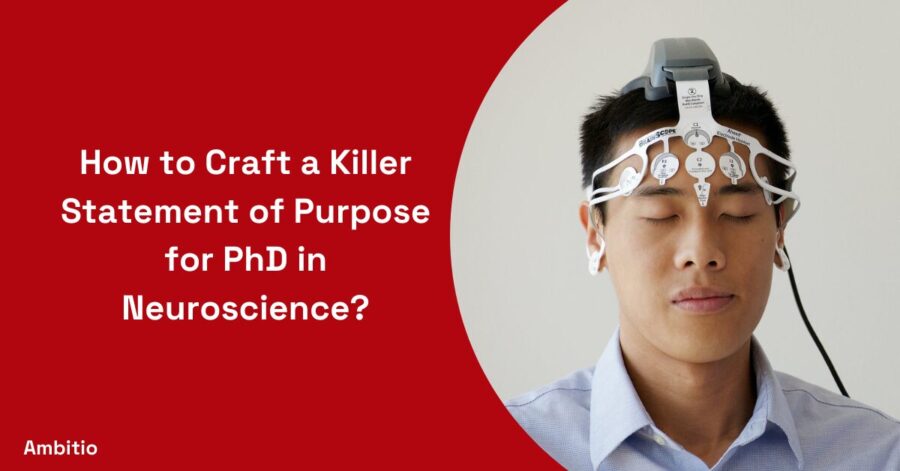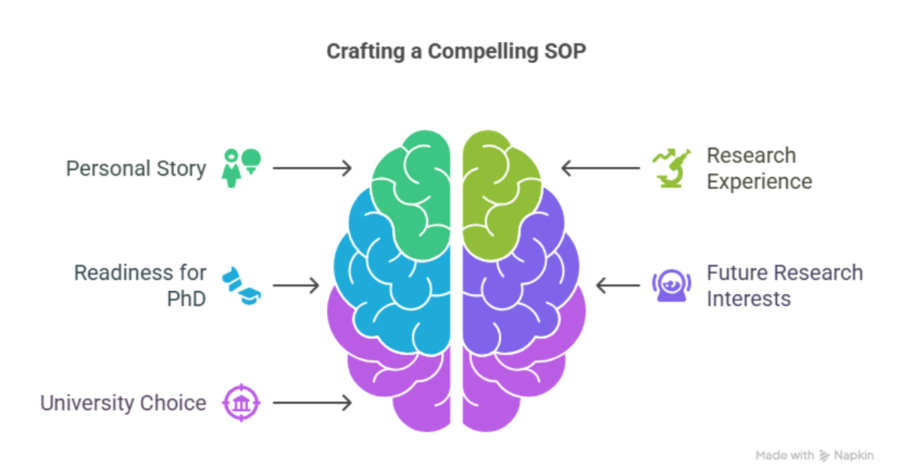5 May 2025
7 minutes read
How to Craft a Killer Statement of Purpose for PhD in Neuroscience (SOP Tips for Indian Students)?

Key Takeaways
- Statement of purpose for PhD in neuroscience must highlight research experience, academic background, and future goals to stand out in applications.
- Statement of purpose for PhD in neuroscience should demonstrate your passion, perseverance, and readiness to contribute to cutting-edge neurological research.
- Statement of purpose for PhD in neuroscience must align with the university’s program strengths and emphasize your ability to advance the field.
Getting a PhD degree in neuroscience is a major step that requires an outstanding statement of purpose. The letter must demonstrate your research experience, academic success, and plans for the future as well as establish that you are the ideal candidate for your preferred university. Admissions committees want to find students who have a solid background in cellular and molecular mechanisms, an interest in discovery, and the dedication needed for more advanced research. This manual will explain how to make an effective SOP that enhances your prospects of getting admitted into a graduate program in neuroscience.
Why Pursue a PhD in Neuroscience After Your Graduate Program?
Neuroscience is an interdisciplinary field that explores the neural mechanisms of human cognition, behavior, and disease. Scientists study everything from neuron cellular function to large-scale brain scan. As the obesity pandemic rises and diseases are becoming increasingly complex, a PhD program provides the opportunity to actually contribute intellectually to the field.

Career Opportunities in Neuroscience:
| Career Path | Description |
|---|---|
| Academia | Tenure-track professor, researcher, or lecturer in neuroscience. |
| Industry | Working in pharmaceutical, biotech, or medical device companies. |
| Healthcare | Clinical neuroscience research, neuropsychology, or medical applications. |
| Science Communication | Writing, journalism, or public outreach about neuroscience advancements. |
What are the Essential Components of a Statement of Purpose Neuroscience PhD?
An effective statement of purpose for a PhD in Neuroscience must thoroughly convey your own particular research interests, relevant experience, and plans for future academic and professional development, in addition to effectively illustrating your commitment to neuroscience research, aligning with the program’s strengths.
Describe how your background and experience position you to provide value and engagement, particularly with collaboration across disciplines, which has become increasingly important to most neuroscience research agendas. An SOP should include the following necessary elements:
- Personal Story – What sparked your interest in neuroscience?
- Research Experience – Explain your past and current research endeavors.
- Academic and Professional Preparedness – Show how your abilities, GPA, and courses make you ready for graduate-level research.
- Future Research Goals – Tell us what you wish to study and why the PhD program is a great match for that.
- Fit with the University – Tell us why you are applying to the program first and how your research goals are a good fit with the research efforts of the faculty.
SOP Starter Kit for Impressing the Admissions Committee During Application
The art of writing a quality Statement of Purpose (SOP) is the magic that will make a lasting impact on the admissions committee in your application. A quality statement of purpose should be able to articulate your passion for the neuroscience program, experience, and how your goals merge with the work of renowned neuroscientists, such as Dr. Williams and Dr. Carter, for example, in advancing the boundaries of neural research.

Sites such as WriteIvy offer step-by-step instructions to fine-tune your SOP and increase your opportunities for admission.
Personal Story: The Spark of Interest
A good statement of purpose typically starts with a personal anecdote. Most applicants have a turning point that brought them to the study. Whether it was the struggle of a family member with a neurological disease or an interest in signal processing in the brain, a strong personal anecdote distinguishes you.
Demonstrating Research Experience
The acceptance committee appreciates direct research experience. Highlight individual projects, methodologies, and outcomes.
Example Research Projects:
- Neuroscience Research: Conducted a two-choice feeding preference study to explore how metabolic signals regulate feeding behavior.
- Experimental Design: Worked with capillary feeding assays to measure neural activity.
- RT-qPCR: Used RT-qPCR to analyze gene expression.
Demonstrating Readiness for PhD Research
PhD students must demonstrate evidence of their ability to organize laboratory workloads, critical thinking skills, and perseverance.
Refer:
- Academic Achievements: GPA, coursework in physiological neuroscience.
- Technical Skills: Neuro-biological imaging, sequencing, and computational analysis.
- Publications & Conferences: If you coauthored a paper or presented findings, highlight this.
Discussing Your Future Research Interests
Clearly state what you want to research in your PhD program. Discuss areas such as:
- Sensitive periods for the trophic actions of leptin.
- Cellular and molecular mechanisms governing metabolic regulation.
- Adaptive neural networks and signal processing.
Why Choose This Particular University?
When writing their SOP, students should include reasons for why they want to do a specific PhD course in the subject.

Factors to Address:
- Faculty members: “I hope to work with Dr. Crane’s continuing work on neuro-biological pathways.”
- Research Facilities: “The university’s advanced imaging labs make it an ideal fit for my research goals.”
- Collaborative Opportunities: “Interdisciplinary programs in neuroscience and immunohistochemistry research provide a great fit for my aspirations.”
Admission Requirements for a PhD in Neuroscience
Pursuing a PhD requires meeting specific academic and research criteria that demonstrate your readiness for advanced study in the field. STEM students with a strong background in biology, psychology, or related disciplines must navigate the application process carefully to showcase their qualifications. Understanding what admissions committees are looking for can significantly increase your chances of acceptance. A well-prepared application not only highlights academic achievements but also allows candidates to spread the love for neuroscience through experience and intellectual contributions.
| Requirement | Description |
| Academic Background | A strong foundation in the subject, biology, or a related field. |
| GRE/SAT/GMAT | Standardized tests may be required, depending on the university. |
| IELTS/TOEFL | Required for non-native English speakers. |
| Letter of Recommendation | Strong recommendations from research advisors or professors. |
| CV & SOP | A well-written neuroscience statement of purpose and CV. |
Sample Essay for Neuroscience Graduates Aspiring for a PhD
Composing a strong sample essay for admission into a PhD program makes the applicant effectively demonstrate their study history, experience with research work, and drive for furtherance of the industry.
Here is a sample SOP for your reference:
The human brain is the most intricate and fascinating architecture known to mankind, governing everything from memory formation to emotional regulation. I became singularly fascinated by the cellular and molecular mechanisms underlying cognition, behavior, and neurological illness during my undergraduate studies. This academic path led me to explore how neural technologies can deepen our understanding of brain function, an interest that has only intensified over time.
My research experience centers around a project investigating neuronal activity in degenerative illnesses using quantitative immunohistochemistry and signal processing techniques. My hands-on experience with both quantitative immunohistochemistry and RT-qPCR make me well qualified to contribute to advanced research in neurobiology.
These skills, acquired while collaborating with senior PIs, supported our coauthored publication on neurological imaging and deepened my interest in adaptive experimental design, sequencing, and the hormone leptin’s role in sensitive metabolic regulation. I am confident that my background has made me well qualified to contribute to the interdisciplinary advancements occurring at the frontier of neuroscience research.
Though I briefly considered alternative career paths and nearly ended my career in research, the perseverance I cultivated during those uncertain years proved essential. As a former ballerina, the discipline and precision required on stage taught me how to persist, focus, and adapt skills I’ve maintained ever since. These qualities helped me in balancing laboratory workloads while achieving numerous successes, from presenting at conventions to collaborating on projects inspired by Otto Octavius’s research on neural interfaces.
Today, I am eager to devote myself fully to a PhD program where I can make true intellectual contributions. I believe I would thrive in a research environment like [University Name], particularly under the guidance of Dr. [Professor’s Name], whose work has led to major advancements in neural networks and metabolic pathways.
I aim to explore how neurobiological systems respond to factors like the growing obesity epidemic, and how this affects brain function and disease progression. These questions, and the ability to address them through rigorous, interdisciplinary research, are only possible through perseverance, curiosity, and collaboration values I hold deeply.
With this mindset, I approach the PhD application not as a formality, but as the next chapter in a journey I could have imagined only through the commitment and purpose I’ve developed over the years.
5 Tips to Write a Perfect Statement of Purpose that Admissions Committees Looking For
Crafting a successful statement of purpose for PhD admissions can feel like a daunting task, especially when it’s your shot at a top-choice program. For PhD applicants, it’s not just about grades, it’s about showing how you’ve been involved in research, how you plan to continue, and what will set you apart.
Here’s the tips for writing statement of purpose on how to elucidate your journey and remind the reader why you belong at their dream university:
Remind the Reader You’re Ready
Reaffirm your readiness for the rigors of a PhD and your commitment to contributing meaningfully at their dream university.
Elucidate Your Research Path
Clearly explain how you got involved in research, what you worked on, and what inspired your academic direction.
Align with the Program
Show how your goals align with the program’s focus and faculty. This makes your SOP tailored, not generic.
Highlight Long-Term Vision
Share how you plan to continue your research post-PhD and what impact you aim to create.
Show What Sets You Apart
Emphasize unique skills, perspectives, or experiences that make you different from other PhD applicants.
Top 10 Best Universities for PhD in Neuroscience
Choosing the right university for a PhD in neuroscience is a significant decision for future researchers. The best universities offer cutting-edge neuroscience research, access to highly renowned PIs, and opportunities to investigate cellular and molecular processes of brain function. The following is a list of the best 10 universities in the world, with details on tuition costs, average salary after PhD, and requirements for admission such as IELTS, TOEFL, GRE, GMAT, and SAT scores.
Top 10 Universities for a PhD in Neuroscience:
| Sl. No. | University | Country | Tuition Fee (Annual) | Average Salary After PhD | Exams Required |
|---|---|---|---|---|---|
| 1 | Harvard University | USA | $51,000 | $100,000 | IELTS, TOEFL, GRE |
| 2 | Stanford University | USA | $56,500 | $105,000 | IELTS, TOEFL, GRE |
| 3 | Massachusetts Institute of Technology (MIT) | USA | $53,790 | $110,000 | IELTS, TOEFL, GRE |
| 4 | University of Oxford | UK | £28,560 | £70,000 | IELTS, TOEFL, GRE |
| 5 | University of Cambridge | UK | £29,000 | £72,000 | IELTS, TOEFL, GRE |
| 6 | University of California, Berkeley | USA | $44,000 | $98,000 | IELTS, TOEFL, GRE |
| 7 | Yale University | USA | $45,700 | $102,000 | IELTS, TOEFL, GRE |
| 8 | University of Toronto | Canada | CAD 28,000 | CAD 90,000 | IELTS, TOEFL, GRE |
| 9 | Columbia University | USA | $54,000 | $97,500 | IELTS, TOEFL, GRE |
| 10 | University of Chicago | USA | $50,000 | $95,000 | IELTS, TOEFL, GRE |
Conclusion
Writing a proper statement of purpose for neuroscience is a difficult job, but having a well-thought-out plan can enhance your chances of being admitted. Highlighting your experience, academic record, and motivation is important. A proper SOP should be in accordance with the graduate program in neuroscience, reflect your ability to make a positive contribution, and outline your future research goals.
By following all these steps, you will develop an SOP that stands you out and gets you accepted into your desired university. For the best SOP guidance, join Ambitio Elite and give wings to your study abroad dreams!
FAQs
What should a statement of purpose for PhD in neuroscience include?
A statement of purpose for PhD in neuroscience should include research experience, academic background, career goals.
How many pages is a PhD statement of purpose?
Typically 1–2 pages, or around 750–1,000 words, depending on the university’s specific guidelines.
How to write a personal statement for neuroscience PhD?
Focus on your research background, specific interests in neuroscience, long-term goals, and why you’re a strong fit for the program and faculty.
Do I need to mention specific faculty in my statement of purpose for PhD in neuroscience?
Yes, a statement of purpose for PhD in neuroscience should mention faculty whose research aligns with your interests.
Is work experience necessary for a strong statement of purpose for PhD in neuroscience?
While not mandatory, research experience strengthens a statement of purpose for PhD in neuroscience.
What is the purpose of studying neuroscience?
To understand the brain’s structure and function, and apply that knowledge to treat neurological, psychological, and behavioral disorders.
Do I need to include my long-term career goals in my statement of purpose for PhD in neuroscience?
Yes, a statement of purpose for PhD in neuroscience should outline your long-term goals to show commitment and clarity in your research vision.
How do you introduce yourself in a statement of purpose?
Start with a brief personal or academic anecdote that sparked your interest in neuroscience and sets the stage for your research journey.

You can study at top universities worldwide!
Get expert tips and tricks to get into top universities with a free expert session.
Book Your Free 30-Minute Session Now! Book a call now




























